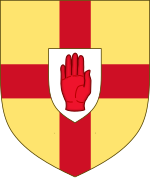There are four provinces of Ireland: Connacht, Leinster, Munster and Ulster. The Irish word for this territorial division, cúige, meaning "fifth part", suggests that there were once five, and at times Meath has been considered to be the fifth province. In the medieval period, however, there were often more than five. The number of provinces and their delimitation fluctuated until 1610, when they were permanently set by the English administration of James I. The provinces of Ireland no longer serve administrative or political purposes but function as historical and cultural entities.

The title of Earl of Ulster has been created six times in the Peerage of Ireland and twice in the Peerage of the United Kingdom. Since 1928, the title has been held by the Duke of Gloucester and is used as a courtesy title by the Duke's eldest son, currently Alexander Windsor, Earl of Ulster. The wife of the Earl of Ulster is known as the Countess of Ulster. Ulster, one of the four traditional provinces of Ireland, consists of nine counties: six of these make up Northern Ireland; the remainder are in the Republic of Ireland.

The House of Burgh or Burke was an ancient Anglo-Norman and later Hiberno-Norman aristocratic dynasty which played a prominent role in the Norman invasion of Ireland, held the earldoms of Kent, Ulster, Clanricarde, and Mayo at various times, and provided queens consort of Scotland and Thomond and Kings of England via a matrilineal line.

William de Burgh was the founder of the House of Burgh in Ireland and elder brother of Hubert de Burgh, 1st Earl of Kent and Geoffrey de Burgh, Bishop of Ely. William is often given the epithet, "the conqueror", but is not to be confused with the English king of the same nickname.
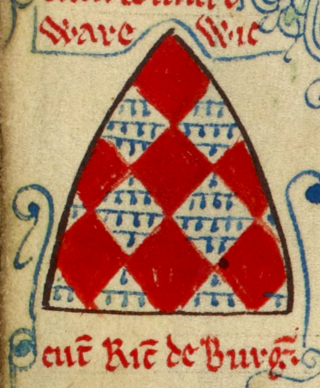
Richard Mór de Burgh, 1st Lord of Connacht, was an Anglo-Norman aristocrat who was Seneschal of Munster and Justiciar of Ireland (1228–32).
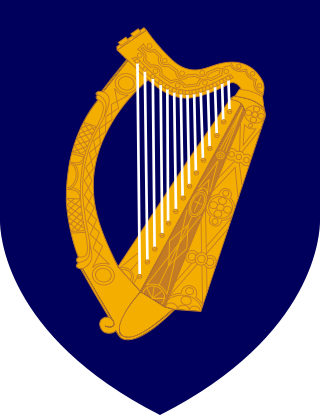
The coat of arms of Ireland is blazoned as Azure a harp Or, stringed Argent. These arms have long been Ireland's heraldic emblem. References to them as being the arms of the king of Ireland can be found as early as the 13th century. These arms were adopted by Henry VIII of England when he ended the period of Lordship of Ireland and declared Ireland to be a kingdom again in 1541. When the crowns of England, Scotland and Ireland were united in 1603, they were integrated into the unified royal coat of arms of kingdoms of England, Scotland and Ireland. The harp was adopted as the emblem of the Irish Free State when it separated from the United Kingdom in 1922. They were registered as the arms of Ireland with the Chief Herald of Ireland on 9 November 1945.
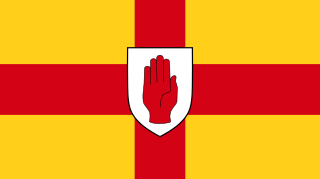
The flag of Ulster is a banner based on the coat of arms of Ulster, used to represent Ulster, one of the four provinces of Ireland. It consists of a red cross on a gold background with a red hand on a white shield in the centre.

The Ulster Banner, also unofficially known as the Ulster Flag or Flag of Northern Ireland, is a heraldic banner taken from the former coat of arms of Northern Ireland, consisting of a red cross on a white field, upon which is a crowned six-pointed star with a red hand in the centre. It was the flag of the former Government of Northern Ireland and common flag of Northern Ireland from 1953 until that government was abolished in 1973 with the passing of the Northern Ireland Constitution Act 1973.

The history of Ireland from 1169–1536 covers the period from the arrival of the Cambro-Normans to the reign of Henry VIII of England, who made himself King of Ireland. After the Norman invasion of 1169–1171, Ireland was under an alternating level of control from Norman lords and the King of England. Previously, Ireland had seen intermittent warfare between provincial kingdoms over the position of High King. This situation was transformed by intervention in these conflicts by Norman mercenaries and later the English crown. After their successful conquest of England, the Normans turned their attention to Ireland. Ireland was made a lordship of the King of England and much of its land was seized by Norman barons. With time, Hiberno-Norman rule shrank to a territory known as the Pale, stretching from Dublin to Dundalk. The Hiberno-Norman lords elsewhere in the country became Gaelicised and integrated in Gaelic society.

John de Burgh was an Irish noble who was the son of Richard Óg de Burgh, 2nd Earl of Ulster and his wife, Margarite.
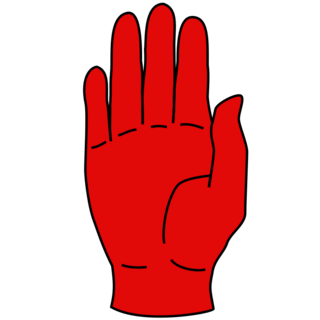
The Red Hand of Ulster is a symbol used in heraldry to denote the Irish province of Ulster and the Northern Uí Néill in particular. It has also been used however by other Irish clans across the island, including the ruling families of western Connacht and the chiefs of the Midlands.
Lord of Connaught was a title used by several Norman barons in Ireland. Granted to William de Burgh, the lordship was claimed by his son, Richard Mor de Burgh, and his descendants.
In heraldry and heraldic vexillology, a blazon is a formal description of a coat of arms, flag or similar emblem, from which the reader can reconstruct the appropriate image. The verb to blazon means to create such a description. The visual depiction of a coat of arms or flag has traditionally had considerable latitude in design, but a verbal blazon specifies the essentially distinctive elements. A coat of arms or flag is therefore primarily defined not by a picture but rather by the wording of its blazon. Blazon is also the specialized language in which a blazon is written, and, as a verb, the act of writing such a description. Blazonry is the art, craft or practice of creating a blazon. The language employed in blazonry has its own vocabulary, grammar and syntax, which becomes essential for comprehension when blazoning a complex coat of arms.

The O'Neill dynasty are a lineage of Irish Gaelic origin that held prominent positions and titles in Ireland and elsewhere. As kings of Cenél nEógain, they were historically one of the most prominent family of the Northern Uí Néill, along with the O'Donnell dynasty. Some O'Neills state that their ancestors were kings of Ailech during the Early Middle Ages, as descendants of Niall of the Nine Hostages.

The coat of arms of Munster consists of three gold crowns on a blue field. Similar crowns were included on the arms of Ireland before being superseded by the golden harp in the 16th century.

The Book of the de Burgos or Book of the Burkes is a late 16th-century Gaelic illuminated manuscript held by the Library of Trinity College Dublin as MS 1440, Historia et Genealogia Familiae de Burgo. The book consists of seventy-five folios, twenty-two of which remain blank.
O'Neill is an Irish surname derived from the Gaelic Ó Néill meaning "descendant of Niall". The Uí Néill dynasty were the foremost dynasty of Ulster, and all Ireland, from the 5th century throughout the medieval period, until the Flight of the Earls in 1607 which saw the end of Gaelic Ireland. O'Neill is one of the most common Irish surnames.
Sir Walter Liath de Burgh was an Anglo-Irish noble whose imprisonment by the Earl of Ulster and death from starvation led to the Earl's murder the following year.

Richard Óg de Burgh, 2nd Earl of Ulster and 3rd Baron of Connaught, called The Red Earl, was one of the most powerful Irish nobles of the late 13th and early 14th centuries and father of Elizabeth, wife of King Robert the Bruce of Scotland.

de Búrca is an Irish Anglo-Norman surname deriving from the ancient Anglo-Norman and Hiberno-Norman noble dynasty, the House of Burgh. In Ireland, the descendants of William de Burgh (c.1160–1206) had the surname de Burgh which was gaelicised in Irish as de Búrca and over the centuries became Búrc then Burke and Bourke.
